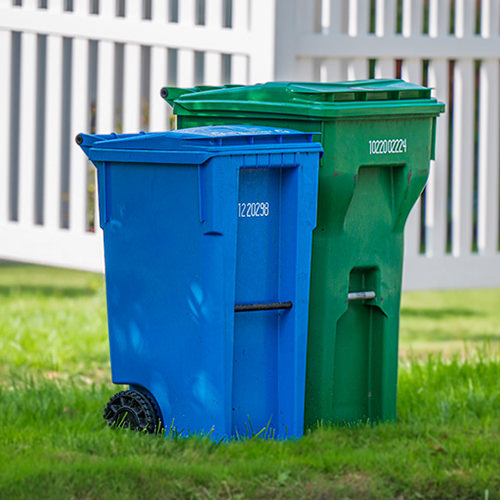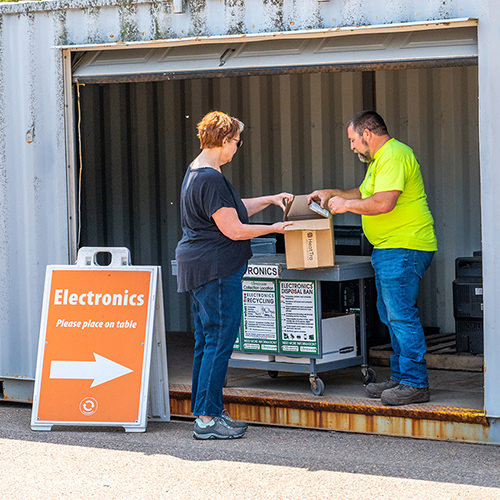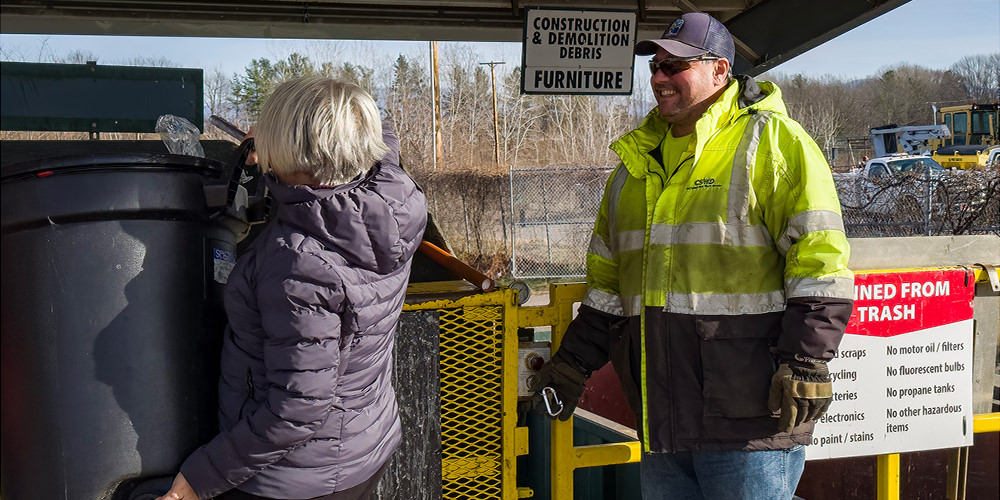CSWD Facilities
CSWD owns and operates eight permanent facilities and a mobile hazardous waste unit to fulfill our mission and serve our members–the towns and cities of Chittenden County. This page also provides links to major non-CSWD waste facilities that complement our services.
Explore this page:
All CSWD Locations
Location and hours information – Click on a map marker to see the address and hours for that facility.
Facility Sensory and Accessibility Guide – This guide is designed to help visitors with sensory sensitivities or disabilities feel more comfortable and confident while exploring our outdoor facilities.
Accepted materials information – Click on a location name below for details about what’s accepted at that site. Jump to Fees Overview. Jump to “Know Before You Go”.
Drop-Off Centers (DOCs)
DOCs provide economical, do-it-yourself options for disposal of household quantities of Trash, Blue-Bin Recycling, Organics, certain Hazardous Waste, and Special Materials. Visit the A to Z List for fees and requirements for specific materials.
Other Vermont Solid Waste Facilities
These facilities provide large loads options for trash disposal, construction and demolition debris recycling, and energy capture of natural and untreated wood. Click the links to visit facility owner’s websites for more information. CSWD does not set fees at these facilities. All tip fees last verified 7/15/2024.
Casella Williston Transfer Station
Accepts large loads of Trash to be transferred to the landfill. Please visit their website for current tip fee and other requirements.
Myers Construction & Demolition Waste Recycling Facility
Accepts large loads of C&D and residential Trash. Please visit their website for current tip fee and other requirements.
McNeil Wood Waste Depot
Accepts natural and untreated wood used as fuel by Burlington Electric Department. No tip fee.
NEWS VT Landfill
Vermont’s only landfill, located in Coventry. Owned and operated by Casella Waste Systems.
A to Z List
Have a specific item in mind? Use our A-Z list search to learn how to properly dispose of it.
Fees & Payment Methods
Drop-Off Centers
Click on each tab in this section for limits, fees, and other critical information about this location.
Fees
Fees shown here are for this category of material. For fees on specific items, please visit our A-Z list.
| Amount | Fees | Notes |
|---|---|---|
| Up to 30 gallons per day | $0.00 | If brought with at least 13 gal. trash to a DOC, or at the Organics Recycling Facility |
| Up to 30 gallons per day | $1.00 for each 5 gallon container | If brought without trash |
Payment Methods
Cash, check with name, current address and phone number, AmEx, Discover, MasterCard and Visa credit /debit cards and Apple/Google Pay. A 3% convenience fee will be added to all credit card transactions.
Fees
Fees shown here are for this category of material. For fees on specific items, please visit our A-Z list.
| Amount | Fees | Notes |
|---|---|---|
| up to 18 gal | $8.00 | Small |
| 19-35 gal | $16.00 | Medium |
| 36-45 gal | $22.00 | Large |
| 46-64 gal | $30.00 | XL |
| 65-100 gal | $48.00 | 1/2 cubic yard |
| 100-150 gal | $72.00 | 3/4 cubic yard |
| 150-200gal | $96.00 | 1 cubic yard |
| C & D materials often contain bulky, heavy materials and are charged at a higher rate than regular household trash. |
Payment Methods
Cash, check with name, current address and phone number, AmEx, Discover, MasterCard and Visa credit /debit cards and Apple/Google Pay. A 3% convenience fee will be added to all credit card transactions.
Fees
Fees shown here are for this category of material. For fees on specific items, please visit our A-Z list.
| Amount | Fees | Notes |
|---|---|---|
| up to 5 gal | $1.00 | XS |
| 5 to 18 gal | $4.00 | Small |
| 19-35 gal | $8.00 | Medium |
| 36-45 gal | $11.00 | Large |
| 46-65 gal | $15.00 | XL |
| 66-100 gal | $24.00 | 1/2 cubic yard |
| 101-150 gal | $36.00 | 3/4 cubic yard |
| 151-200 gal | $48.00 | 1 cubic yard |
| Per Single Item | varies | Operator will determine final price based on size of item |
Payment Methods
Cash, check with name, current address and phone number, AmEx, Discover, MasterCard and Visa credit /debit cards and Apple/Google Pay. A 3% convenience fee will be added to all credit card transactions.
Fees
Fees shown here are for this category of material. For fees on specific items, please visit our A-Z list.
| Amount | Fees | Notes |
|---|---|---|
| up to 1 cubic yard | $0.00 | If brought with at least 13 gallons of trash. |
| up to 1 cubic yard | $2.00 | If brought without trash |
| Each additional yard | $5.00 | up to 3 cubic yards accepted daily |
Payment Methods
Cash, check with name, current address and phone number, AmEx, Discover, MasterCard and Visa credit /debit cards and Apple/Google Pay. A 3% convenience fee will be added to all credit card transactions.
Environmental Depot (By appointment only)
Click on each tab in this section for limits, fees, and other critical information about this location.
Fees
Fees shown here are for this category of material. For fees on specific items, please visit our A-Z list.
| Amount | Fees | Notes |
|---|---|---|
| $0.00 |
Payment Methods
Cash, check with name, current address and phone number, AmEx, Discover, MasterCard and Visa credit /debit cards and Apple/Google Pay. A 3% convenience fee will be added to all credit card transactions.
Fees
Fees shown here are for this category of material. For fees on specific items, please visit our A-Z list.
| Amount | Fees | Notes |
|---|---|---|
| Varies | See the What will it cost me? tab on our Hazardous Waste page. |
Payment Methods
Cash, check with name, current address and phone number, AmEx, Discover, MasterCard and Visa credit /debit cards and Apple/Google Pay. A 3% convenience fee will be added to all credit card transactions.
Organics Recycling Facility
Fees
Fees shown here are for this category of material. For fees on specific items, please visit our A-Z list.
| Amount | Fees | Notes |
|---|---|---|
| up to 30 gallons | $0.00 | Residential drop-off |
| per ton | $70.00 | Commercial drop-off |
Payment Methods
Cash, check with name, current address and phone number, AmEx, Discover, MasterCard and Visa credit /debit cards and Apple/Google Pay. A 3% convenience fee will be added to all credit card transactions.
Materials Recycling Facility
Fees
Fees shown here are for this category of material. For fees on specific items, please visit our A-Z list.
| Amount | Fees | Notes |
|---|---|---|
| per ton | $90.00 |
Payment Methods
Cash, check with name, current address and phone number, AmEx, Discover, MasterCard and Visa credit /debit cards and Apple/Google Pay. A 3% convenience fee will be added to all credit card transactions.
Know Before You Go!
Answers to common waste-related questions.



